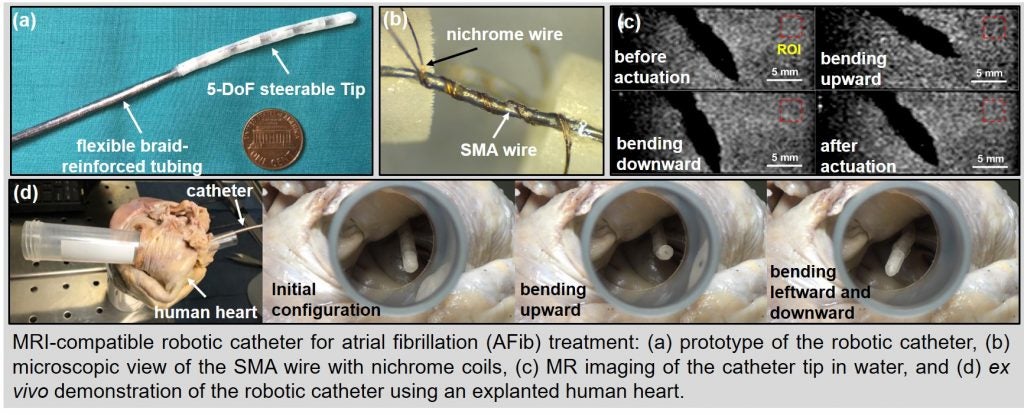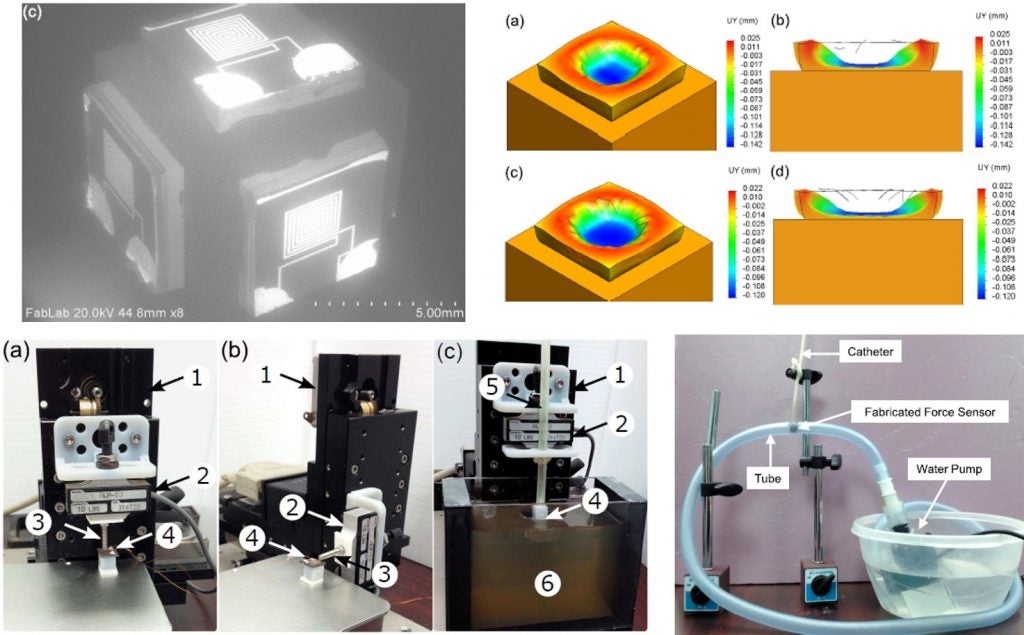Flexible Catheter Robots for Atrial Fibrillation Diagnosis and Treatment
(This project was completed at Georgia Tech under Dr. Jaydev P. Desai)
Motivation: AFib is a disease involving irregular heartbeat caused by ectopic electrical signals from pulmonary veins (PVs) in the left atrium. To block ectopic electrical signals, an endovascular catheter can be manipulated to perform radiofrequency (RF) ablation on the heart tissue near PVs. Since MR imaging can provide visual evaluation of fibrosis, which is an indicator of the performance of RF ablation, we have developed an MRI-compatible robotic catheter to perform ablation and evaluation simultaneously and to improve the success rate of AFib treatment.
Project Highlights: The developed catheter consists of braid-reinforced tubing and a steerable tip comprised of multiple SMA bending modules to perform dexterous navigation in the left atrium. Each bending module is manufactured by integrating a pair of antagonistic SMA wires with two 3D-printed plastic rigid links. An ultra-thin two-stranded nichrome wire is routed around each SMA wire using a customized jig so that the SMA wire can be thermally energized via conductive heating by applying electric current to nichrome coils. Due to the large resistance of the nichrome wire, the electric current required for SMA actuation is significantly reduced compared to Joule heating actuation. Since the electromagnetic fields induced by the two nichrome strands are small and concentrated in the SMA wire like a solenoid, the MR imaging noise caused by SMA actuation is negligible. To ensure an appropriate amount of ablation energy is delivered, the catheter contact force needs to be measured. Thus, a flexible tri-axial force sensor was fabricated based on polydimethylsiloxane (PDMS) using MEMS techniques. We experimentally calibrated the developed sensor and evaluated its working performance using gelatin phantoms and an in vitro circulatory system.
For SMA bending modules, we have developed a planar bending sensor by using flexible adhesive to combine two FBG fibers with an ultra-thin superelastic nitinol strip made using wire EDM. When the sensor is deflected, axial normal strain is induced in both FBG fibers due to the shear stress in the adhesive, resulting in a wavelength shift of the reflected light. Due to the geometric symmetry of the sensor, the difference in the wavelength shifts of the two fibers is exclusively determined by the curvature of the sensor, regardless of temperature variation due to SMA actuation. A three-dimensional (3D) force sensor was developed to provide the real-time measurement of tri-axial catheter contact force. The 3D force sensor consists of a plastic cubic bead and five flexible force sensors. Each flexible force sensor was made of a PEDOT:PSS strain gauge and a PDMS bump on a flexible PDMS substrate. Calibration results show that the fabricated sensor has a linear response in the force range required for RF ablation.
Archival Publications:
Jun Sheng, Xuefeng Wang, Timm-Michael L. Dickfeld, and Jaydev P. Desai, “Towards the development of a steerable and MRI-compatible cardiac catheter for atrial fibrillation treatment,” IEEE Robotics and Automation Letters, vol. 3, no.4, pp. 4038-4045, Oct. 2018.
Hardik J. Pandya, Jun Sheng, and Jaydev P. Desai, “MEMS-based flexible force sensor for tri-axial catheter contact force measurement,” IEEE/ASME Journal of Microelectromechanical Systems, vol. 26, no.1, pp. 264-272, Feb. 2017.
Refereed Conference Publications:
Jun Sheng, Nancy J. Deaton, and Jaydev P. Desai, “A large-deflection FBG bending sensor for the SMA bending module,” 2019 IEEE International Conference on Robotics and Automation
Hardik J. Pandya, Jun Sheng, and Jaydev P. Desai, “Towards a tri-axial flexible force sensor for catheter contact force measurement,” 2016 IEEE SENSORS, pp. 1-3, 2016.

